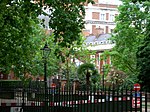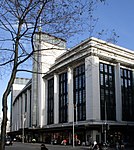Embassy of Romania, London
Buildings and structures in the City of WestminsterBuildings and structures in the Royal Borough of Kensington and ChelseaDiplomatic missions in LondonDiplomatic missions of RomaniaRomania–United Kingdom relations ... and 1 more
South Kensington

The Embassy of Romania in London is the diplomatic mission of Romania in the United Kingdom. Diplomatic relations between the two countries were established in 1880. The embassy is one of several located in Kensington Palace Gardens, at 4 Palace Green. Romania also maintains a Consulate at 344 Kensington High Street, Holland Park and a Cultural Institute at 1 Belgrave Square, Belgravia.
Excerpt from the Wikipedia article Embassy of Romania, London (License: CC BY-SA 3.0, Authors, Images).Embassy of Romania, London
Palace Green, London South Kensington (Royal Borough of Kensington and Chelsea)
Geographical coordinates (GPS) Address External links Nearby Places Show on map
Geographical coordinates (GPS)
| Latitude | Longitude |
|---|---|
| N 51.503888888889 ° | E -0.19 ° |
Address
Embassy of Romania
Palace Green 4
W8 4QD London, South Kensington (Royal Borough of Kensington and Chelsea)
England, United Kingdom
Open on Google Maps







